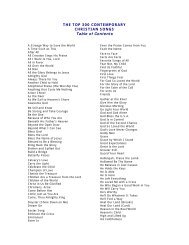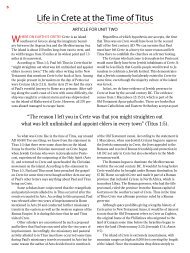6X9 book template
6X9 book template
6X9 book template
Create successful ePaper yourself
Turn your PDF publications into a flip-book with our unique Google optimized e-Paper software.
ONEThe Maelstrom of MediocrityThe Maelstrom, a tidewater whirlpool inthe Lofoden Islands off Norway’s northerncoast, has been widely known for centuriesfor its strength and dangerous current.Since it poses a threat to ships,Edgar Allan Poe described it with greatimagination in his celebrated short story titledA Descent into the Maelstrom. 112
The Maelstrom of MediocrityPoe’s narrator is led to a high cliff on Helseggen mountain overlookingthe Maelstrom by a man who survived a traumatic experience inthis vicious vortex that swallows ships, animals, and anything else in itspath. During a fishing trip, he and his two brothers encountered an awfulstorm that damaged their boat, washed the younger brother overboard,and pulled the survivors into the dreaded Maelstrom. The boatspun around and around, slowly descending for about an hour, withthe man tightly grasping a ringbolt in the deck. The older brother atfirst stood at the back of the vessel holding on to a water cask so hewould not be swept overboard, but he then suddenly moved towardthe man and pried the ringbolt from his fingers. The older brother thenused the ringbolt to secure himself. Aggravated by his brother’s selfishaction, the man took his place at the water cask.As the descent into the abyss continued, the man noticed the movementof the current and various objects that were floating around them—a fir tree, wrecked ships, furniture, and barrels. He suddenly rememberedthat sometimes objects would wash ashore near Lofoden undamagedbecause they were in the current at exactly the right time andfloated up to the surface when the whirlpool calmed down. He observedthat the cylinder-shaped objects descended slower than the rest.With this knowledge, he tied himself to the water cask that his brotherhad left behind, tried unsuccessfully to get his brother to do the same,cut himself free from the sinking boat, and jumped into the raging waters.The plan worked, as his barrel’s shape slowed its descent. He helplesslywatched as his brother and their boat descended to a waterygrave at the Maelstrom’s bottom.Eventually, the man and his barrel began to rise from the depthsduring the whirlpool’s calming period. He surfaced and was rescued byfellow mariners who acknowledged that his hair had changed fromblack to white but refused to believe his tale. The man does not expectthe narrator to believe it either, for he ends the story with these words:“I can scarcely expect you to put more faith in it than did the merryfishermen of Lofoden.”Christian ministry, by its very nature, is countercultural, and yet thedominant culture shapes our work more than we would like to admit.13
QUANTUM MINISTRYNowhere is this more evident than in our growing acceptance of underachievement.Slowly but surely, we are being swept along in the maelstromof mediocrity—a strong and dangerous current that keeps usfrom rising up to maximize our God-given potential.You do not need a special gift of discernment to see what is happeningthroughout the land. When the late TV anchorwoman Jessica Savitchreceived an honorary degree from Columbia College back in 1983,her challenge to the students included the following assessment of theway things were at that time:As a reporter, I have had a chance to observe people at the top ofjust about every field. And it makes no difference if they are male orfemale, black or white, old or young, the people I observed succeedingare those who have been taught or who teach themselves tostrive for excellence. The pleasure comes from knowing you havedone a job the best way you know how. It seems to me, however, inour modern society that there is very little done these days in pursuitof excellence. But whatever there is, it stands out for its rarity. 2If excellence was rare in 1983, it is even rarer now. Mediocrity ismainstream. Its waters transcend all human categories—race, nationality,gender, occupation, socioeconomic class, and so on. According to datacollected by the Gallup Organization, less than 30 percent of Americanworkers are fully engaged at work; 55 percent are not engaged; 19 percentare actively disengaged, meaning that they are not only unhappy at workbut also regularly share those feelings with colleagues. Furthermore, thelonger employees stay with the same job, the less engaged they become. 3My hunch is that you have at least one of the actively disengaged in yourchurch, easily identified during worship services by folded arms and a facialexpression that says, “Preacher, bless me if you can!”Those who try to excel in the workplace are certainly going againstthe flow, and their behavior is disdainfully labeled schmoozing or kissingup to the boss because it shows up the average worker. Americansdo not want mediocre performance in surgery, but we seem to accept itin almost every other field.This cultural phenomenon should not surprise anyone, consideringthe well-documented lowering of academic standards in our nation’s14
The Maelstrom of Mediocrityschools. Unsuspecting kids step into the shallow, subtle currents of educationalmediocrity with little or no thought of where the waters maylead them. Alarming test scores reveal that most U.S. children are underachieving,because at all ability levels they lag behind children inmany European and East Asian nations. Perhaps even more disturbing isthat our own expectations have slipped far below what they used to be.Outside the classroom, our youth are inundated with the “slackingis cool” message from pop music, television, movies, and ads. Teenswho take responsibility are labeled geeks, nerds, and other less-flatteringterms; they soon become the objects of ridicule and harassment. Eagerto gain acceptance from the in crowd, many gifted young folk settlefor less than their best. The waters are rising and swirling.“A descent into the maelstrom” could continue in college, as academic-performancelessons learned in elementary and secondary schools areoften reinforced there. Most major universities now award a significantlydiluted bachelor’s degree. Can you believe that many university Englishmajors are no longer required to read Shakespeare or Chaucer!Grade inflation at our colleges and universities gives new meaning tothe term “higher education.” 4It’s no surprise that underachieving students usually become underachieversin the workforce. We know them well; they are our churchmembers, friends, relatives, and neighbors. Many of these would-beclimbers showed great promise in the formative years but somehow gotcaught in the cultural undercurrent and settled for professional mediocrity.They can be identified by one or more of the following tendencies: Inconsistent or insufficient effort A lack of real engagement Ambivalence in decision making Lack of follow-through Disorganization Inability to reach goals A tendency to quit things just as one begins to achieve success Procrastination Involvement in jobs and situations that demand less than one’s capabilities15
QUANTUM MINISTRY A paralyzing fear of failureWe have no problem identifying underachievement in others. Asyou perused the list of tendencies, names of colleagues, friends, andfamily members probably came to mind. Perhaps you were saddenedby thoughts of what might have been. But what about you? Did yousee yourself there? To recognize these potential-inhibiting patterns inyour own life is to take the initial steps of the joyful journey into amore fruitful ministry. Remember, you do not have to be sick to getbetter.It is much easier to recognize underachievement than to understandits underlying causes. In Your Own Worst Enemy (the first <strong>book</strong> devotedexclusively to adult underachievement), Dr. Kenneth Christian shedslight on this subject by describing 12 “self-limiting styles,” 5 presentedhere in summary form: Sleepers: A style seen most often in those from families or communitieswithout models or traditions of high achievement. Sleeperslack accurate information about themselves, the extent of theirtalent, and ways to express it. A lack of support, opportunities,and guidance often play a role in the failure of sleepers to makeearly contact with their possibilities, as does a parental preferencenot to spoil or inflate them. Floaters/coasters: Aware of their abilities, they see opportunities,and often are even pursued by others, but rarely act on their possibilities.Some are temperamentally hesitant and slow to participate;others can be emotionally withdrawn or indolent and lackingin ambition. Their chief characteristics are passivity, lack ofinitiative, and disengagement. Checkmates: Have multiple but contradictory ambitions and feelhopelessly immobilized. Checkmates are often perfectionists whounconsciously fear change and arrange their lives so as to makechange virtually impossible. Extreme non-risk-takers: Focus totally on minimizing risks intheir lives; avoid situations in which they could possibly fail; gravitatetoward occupations, relationships, and activities that do notpresent serious challenges or reflect their real interests.16
The Maelstrom of Mediocrity Delayers: Make postponing major decisions and commitmentstheir central theme; procrastinate; miss deadlines; postpone theonset of adult life, and drift, evading permanence, engagement,and seriousness; sample many things superficially. Stop-shorts: Aware of their abilities, stop-shorts entertain ambitionsand make significant progress but firmly hold back fromreaching their goals. Their arrested progress is often related to afear of completing a life step or of taking on some role that will bethe outcome of fully realizing an aim. They take course requirementsbut do not complete the thesis, get a certificate but do notembark on the related career, finish law school but never pass thebar, suffer writer’s block and fail to complete the novel. Self-doubters/self-attackers: Block their success by holdinghigh standards they feel they can never possibly meet and forwhich they seldom strive; emphasize their own faults and failings;often feel that any personal accomplishment was a fluke. Theyavoid demands and expectations out of a fear of failing. Charmers: Have good intentions but are inclined to use their engaginginterpersonal abilities as a substitute for effort; often use adisarming sense of humor to diffuse criticism when they let thingsslide; develop a pattern of unreliability. Extreme risk-takers: Energetic and impulsive, they limit theirsuccess by habitually taking unnecessary risks; would rather fail ina blaze of glory than succeed through patient effort. Rebels: Aggressively strike out at the world and resist authority;unwilling to conform; suspicious of what they feel are others’ attemptsto exploit or control them. Misunderstood geniuses: Build a life around the notion thattheir talent sets them apart from others and that their lack of successis due to the misunderstanding, jealousy, and incompetenceof others; use excuses; say their ideas are not mainstream or aretoo advanced for others to understand them; are temperamental. Best-or-nothings: Highly talented people for whom successcomes easily or not at all; will not participate, if they cannot be thevery best at something; progressively drop one activity after an-17
QUANTUM MINISTRYother; narrow their lives down to a few activities at which theyclearly excel.Your Own Worst Enemy is a must read for those who are serious aboutbreaking the habit of adult underachievement. Filled with persuasivecase studies, it offers scholarly yet practical advice for breaking throughthe barriers that keep us from approaching our potential. A radio interviewfeaturing Dr. Kenneth Christian became the catalyst for this <strong>book</strong>,and since there are so few people writing on the subject of adult underachievement,I have drawn extensively from his groundbreaking research.Yet my primary focus has remained on the somewhat uniquefactors related to underachievement in the pastoral ranks—the subjectof the next chapter.I would be remiss to omit attention deficit disorder (ADD) and attentiondeficit hyperactivity disorder (ADHD) from any discussion ofunderachievement, since the term consistently appears on the lists ofsymptoms for both of these conditions. Unfortunately, many of thosewho have been diagnosed with adult ADD or ADHD were labeled aslazy, slow-learning, underachieving, problem kids—a heavy burden tobear when you already know that you have disappointed yourself andothers. Prescription medications and professional counseling may assistthese folk in focusing on the task at hand, increasing their productivity,enhancing their relationships, and relieving the load of false guilt.Now before looking further at underachievement, I want to say abrief word about its opposite—overachievement. Predictably, this term hasbeen popularized amid the maelstrom of mediocrity. You often hear itin connection with men like Jim Leonhard and Buddy Marston. Butwhat does the word actually suggest? Can a person really achieve morethan he or she is capable of? Of course not. Overachiever is a misnomer;yet, we have applied it to people who achieve more than they should—that is, more than others expect of them. I theorize that the averageJoes and Janes of the world are quick to label the maximizing personan overachiever because it implies an impossible level of performance,thus excusing the mediocrity in their own lives.18









